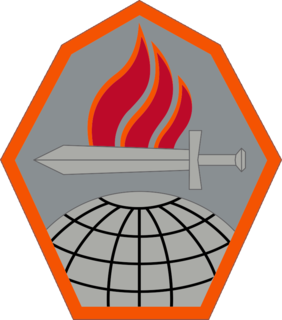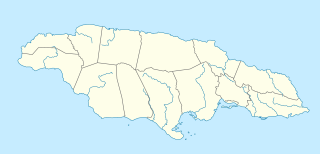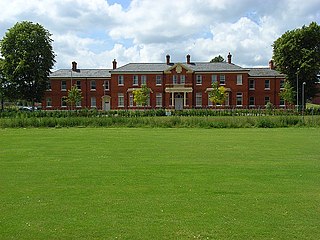
The Princess Royal Barracks, Deepcut, commonly referred to as Deepcut Barracks, was the headquarters of the Royal Logistic Corps (RLC) of the British Army and the Defence College of Logistics, Policing and Administration. Located near Camberley, Surrey, England, it was the headquarters of the Royal Army Ordnance Corps until the formation of the RLC in 1993. At that time, it was known as Blackdown Barracks. The barracks remain home to the RLC Museum, the Band of the RLC, The Defence Logistics School and 25 Training Support Regiment RLC, which trains the officers and soldiers in a range of logistical skills.

Fort Gordon, formerly known as Camp Gordon, is a United States Army installation established in October 1941. It is the current home of the United States Army Signal Corps, United States Army Cyber Corps, and Cyber Center of Excellence. It was once the home of The Provost Marshal General School and Civil Affairs School. The fort is located slightly southeast of Grovetown, Georgia and southwest of the city Augusta, Georgia. The main component of the post is the Advanced Individual Training for Signal Corps military occupational specialties. In 1966–68 the Army's Signal Officer Candidate School graduated over 2,200 Signal officers. Signals Intelligence has become more visible and comprises more and more of the fort's duties.

The Royal Artillery Barracks at Woolwich in the Royal Borough of Greenwich, London, was the home of the Royal Artillery from 1776 until 2007.

The Royal Army Ordnance Corps (RAOC) was a corps of the British Army. At its renaming as a Royal Corps in 1918 it was both a supply and repair corps. In the supply area it had responsibility for weapons, armoured vehicles and other military equipment, ammunition and clothing and certain minor functions such as laundry, mobile baths and photography. The RAOC was also responsible for a major element of the repair of Army equipment. In 1942 the latter function was transferred to the Royal Electrical and Mechanical Engineers (REME) and the vehicle storage and spares responsibilities of the Royal Army Service Corps were in turn passed over to the RAOC. The RAOC retained repair responsibilities for ammunition, clothing and certain ranges of general stores. In 1964 the McLeod Reorganisation of Army Logistics resulted in the RAOC absorbing petroleum, rations and accommodation stores functions from the Royal Army Service Corps as well as the Army Fire Service, barrack services, sponsorship of NAAFI (EFI) and the management of staff clerks from the same Corps. On 5 April 1993, the RAOC was one of the corps that amalgamated to form The Royal Logistic Corps (RLC).

The Jefferson Barracks Military Post is located on the Mississippi River at Lemay, Missouri, south of St. Louis. It was an important and active U.S. Army installation from 1826 through 1946. It is the oldest operating U.S. military installation west of the Mississippi River, and it is now used as a base for the Army and Air National Guard. A Veterans Affairs healthcare system campus is located on the southern portion of the base and is also the headquarters for the Veterans Canteen Service.
Canadian Forces Detachment Dundurn is a Canadian Forces facility located near the town of Dundurn, Saskatchewan and approximately 40 km south of Saskatoon, Saskatchewan.
The Defence Explosive Ordnance Disposal, Munitions and Search Training Regiment is an element of the Royal School of Military Engineering responsible for the delivery of training to British Army Ammunition Technicians, Ammunition Technical Officers and Search Operators. The Regiment delivers training from two locations: Marlborough Barracks, MoD Kineton near Kineton, Warwickshire and St George's Barracks, MoD Bicester, near Bicester, Oxfordshire.

Richmond Barracks was a British Army barracks in Inchicore, Dublin, Ireland. It is now a museum.

Newcastle is a settlement in the Blue Mountains of Jamaica. Formerly a military hill station for the British Army it is now a training centre for the Jamaica Defence Force.

Camp Navajo was originally opened in 1942 in Bellemont, Arizona. It was originally designated Navajo Ordnance Depot, and its primary use was the storage of ammunition used in the Pacific Theater of World War II. It was renamed Navajo Army Depot in 1965, changed to Navajo Depot Activity in 1982, and then changed in 1993 to its current name. In 1993 the Department of Defense transferred all ammunition activities to Hawthorne Army Ammunition Plant in Nevada. Following the transfer, Camp Navajo remained federal land under the Department of the Army, overseen by the Army National Guard. The Ordnance Operations and Industrial Park are managed by the Arizona Department of Emergency of Military Affairs (AZDEMA), and the military training mission remains managed by the Arizona Army National Guard. All authority is given through the Department of Defense Army Corps of Engineers regarding engineering, design, and construction management processes for potential DoD and DoD like customers.

Camp Withycombe, located in Clackamas County, Oregon, United States, was originally established as Camp Benson after Governor Frank W. Benson, but was later renamed Camp Withycombe during World War I for Governor James Withycombe.

Glencorse Barracks is a British Army barracks situated in Glencorse just outside the town of Penicuik in Midlothian, Scotland. It is one of the three barracks which make up the City of Edinburgh Garrison, with Dreghorn and Redford Barracks. It has been the home for The Royal Highland Fusiliers, 2nd Battalion, The Royal Regiment of Scotland since 2006.

Wyvern Barracks is a military installation on Topsham Road in Exeter.

Chetwynd Barracks is a military installation at Chilwell in Nottinghamshire.

Tidworth Camp is a military installation at Tidworth in Wiltshire.

MoD Bicester is a large military storage and distribution centre just outside Bicester in Oxfordshire.

Chattenden and Lodge Hill Military Camps were British Army training camps in Chattenden and Hoo St Werburgh in Kent. They were built as ordnance depots and functioned as such through to the second half of the twentieth century.
The Defence Stores Department was a department of the New Zealand Defence Department responsible for the purchase, receipt, issue and repair of stores, initially for the Armed Constabulary and then the Permanent and Volunteer Forces of New Zealand from 1862 to 1917.
















